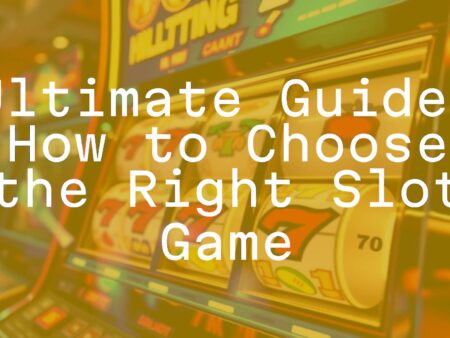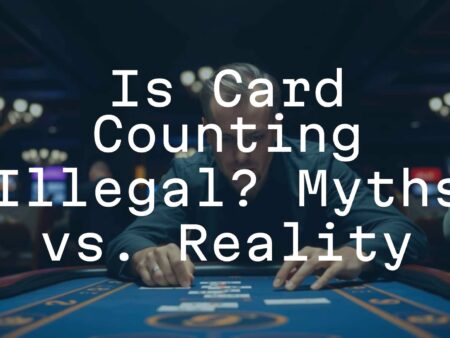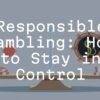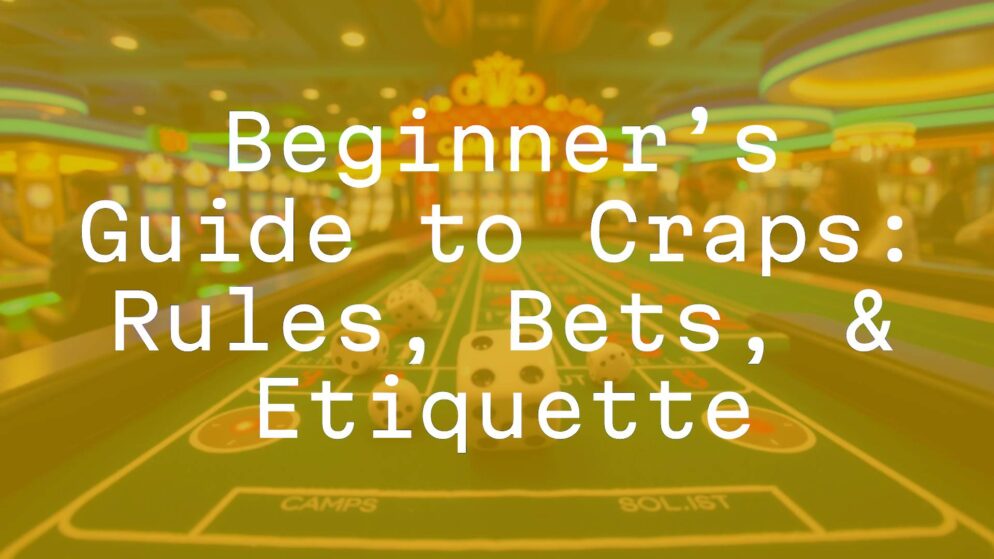
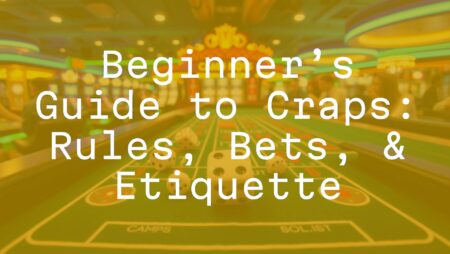
Craps can look chaotic, with loud cheers, dice flying, and what seem like endless ways to bet. But at its core, craps is a simple game based on what happens when you roll two dice. This guide will explain the basics of the craps table, walk you through the main rules, outline the different types of bets, and show you how to feel comfortable joining a game in a casino. If you’ve felt nervous about playing craps, don’t worry-by the time you finish reading, you’ll be ready to play confidently.
What Is Craps?
Basic concept and object of the game
Craps is a fast and lively game built around rolling two dice. It’s all about chance, but players can make different betting choices that change their experience. The goal is to predict the results of the dice, betting on whether certain numbers will come up. Unlike other casino games where you’re always against the house, craps feels more social, because many players often bet with the person rolling the dice, creating a team feeling at the table.
The game works in rounds, and the current roller is called the “shooter.” All bets for a roll must be placed before the shooter throws the dice. Although the table layout might seem confusing, the main idea is simple: did the dice hit your chosen number, or not?
The Craps Table and Equipment
Main areas of the craps table
The craps table is long and covered with green felt, marked with many spots where you can put down bets. The table is usually mirrored on both sides so more people can play, and has high walls to keep the dice in. In the middle, you’ll find the Proposition Bets section, a colorful area for high-risk, big-payoff bets.
Next to the center are the primary betting areas: the “Pass Line” and “Don’t Pass Line” shapes cover the outside edges and are the most-used bets. Right by these are the “Come” and “Don’t Come” boxes, which are used after the first roll. Larger boxes marked with numbers (4, 5, 6, 8, 9, and 10) are for “Place Bets.” The “Field” is another area, often in the middle, for bets that only last one roll. Learning these main areas will help you find your way around the table.

Who does what at the craps table?
A craps game is managed by several casino workers. Knowing their jobs helps you play more easily. Each side of the table has a “Dealer” who handles players’ chips, pays winnings, and collects losing bets. These dealers deal with players the most and also answer questions.
The “Stickperson” is in the middle and handles the dice with a long stick. They call out the dice numbers, control the dice, and manage the middle bets. Their job is loud and keeps the table lively. Above the table is the “Boxperson,” who watches over all the action, manages the chips, and makes sure the game is fair. You usually won’t talk to the Boxperson, but they’re there in charge. Lastly, the “Shooter” is the player rolling the dice, whose throws set the pace for everyone’s bets.

Basic craps terms to know
Craps can feel like a foreign language. Here are some key words you’ll hear:
- Shooter: The player rolling the dice right now.
- Come-Out Roll: The first roll of a round or after a new shooter starts.
- Point: If the first roll lands 4, 5, 6, 8, 9, or 10, that number is called the Point, which the shooter tries to roll again before a 7.
- Craps: If the first roll is 2, 3, or 12, Pass Line bets lose right away.
- Natural: If the first roll is 7 or 11, Pass Line bets win right away.
- Seven Out: After a Point, if a 7 is rolled before the Point hits again, the round ends and most bets lose.
- Hardway: Rolling a number as pairs (for example, double 4s for a “Hard 8”).
- Easy Way: Rolling a number any way except with a pair (such as 5+3 for 8).
- Puck: A disc the dealer uses to mark if the Point is on (“ON”) or not (“OFF”).
- Boxcars: Rolling a double 6 (12).
- Aces: Rolling a double 1 (2).
- Yo (Yo-Eleven): Rolling an 11.
Knowing these words makes following the game much easier.
Craps Rules for Beginners
How a round of craps works
A round of craps has two parts: the Come-Out phase and the Point phase. The shooter puts a bet on the “Pass Line” or “Don’t Pass Line.” This is required to roll. The round starts with the Come-Out Roll.
If the Come-Out Roll is a 7 or 11, Pass Line bets win. If it’s a 2, 3, or 12, Pass Line bets lose. If the roll is 4, 5, 6, 8, 9, or 10, that number becomes the Point, and the next phase starts. Now, the shooter keeps rolling, trying to hit the Point again before rolling a 7. If the Point comes up, Pass Line bets win and a new round starts. If a 7 is rolled before the Point, it’s “Seven Out,” bets lose, and a new shooter takes over.
The come-out roll and what can happen
The Come-Out Roll is the first and most important roll of each round, deciding instant wins, losses, or what the Point will be. Here’s what can happen:
- Natural Win: A roll of 7 or 11 means Pass Line bets win right away. Don’t Pass bets lose.
- Craps (Instant Loss): A roll of 2, 3, or 12 means Pass Line bets lose immediately. For Don’t Pass, 2 or 3 wins, and 12 is a tie (money back).
- Point Set: If 4, 5, 6, 8, 9, or 10 is rolled, that becomes the Point. The dealer puts a puck on that number, and now the goal is to roll it again before a 7 shows up.
This first roll sets up the rest of the round and brings a lot of excitement to the table.

What does “the Point” mean in craps?
The Point is the number the shooter needs to roll again, once it is set, before rolling a 7. If the Point is 8, the shooter keeps rolling until they hit another 8 (which means Pass Line wins) or a 7 (which means Pass Line loses and the dice move to the next shooter). The Point is like a target number and controls what happens for the rest of that shooter’s round.
Types of Bets in Craps
Pass Line and Don’t Pass Line bets
The Pass Line and Don’t Pass Line bets are the two main ways to bet in craps, giving you some of the best chances to win. Most players start with these bets before the first roll (“Come-Out Roll”).
Pass Line: You’re betting the shooter will win.
- On the first roll: A 7 or 11 means you win. A 2, 3, or 12 means you lose.
- If a Point comes up: You win if the Point appears before a 7. You lose if a 7 comes before the Point.
This pays 1:1 (even money).
Don’t Pass Line: You’re betting against the shooter.
- On the first roll: You win if it’s 2 or 3. You lose if it’s 7 or 11. 12 is a tie and your bet returns.
- If a Point comes up: You win if a 7 rolls before the Point; you lose if the Point comes up before a 7.
This also pays even money and has slightly better odds, but most people prefer to root with the shooter.

Come and Don’t Come bets
After the Point is set, you can make Come and Don’t Come bets. They work like Pass and Don’t Pass, but can be placed on any roll after the Come-Out Roll.
Come Bet:
- Next roll: You win with 7 or 11, lose with 2, 3, or 12.
- Other numbers: That number becomes your “Come Point.” If it rolls again before a 7, you win. If a 7 comes first, you lose.
Don’t Come Bet:
- Next roll: Win with 2 or 3, lose with 7 or 11, 12 is a tie.
- Other numbers: That number becomes your “Don’t Come Point.” If a 7 shows up before your number, you win. If your number rolls first, you lose.
These bets let you jump in at any time and make the game more interesting.
Odds bets
Odds Bets are extra bets you can only make after a Point (or Come Point) is established and after you have a Pass, Don’t Pass, Come, or Don’t Come bet. These are loved because the casino doesn’t have an edge on them.
Pass/Come Odds: You’re backing your Point or Come Point. The payoffs match the real chance of winning:
- 4 or 10: Pays 2 to 1
- 5 or 9: Pays 3 to 2
- 6 or 8: Pays 6 to 5
You place chips behind your Pass/Come bet.
Don’t Pass/Don’t Come Odds: Here, you’re betting that a 7 shows up before the Point.
- 4 or 10: Pays 1 to 2
- 5 or 9: Pays 2 to 3
- 6 or 8: Pays 5 to 6
These go just next to your Don’t Pass/Don’t Come bet. Since Odds Bets pay out with no casino edge, it’s smart to bet as much as the table allows.
Place bets and Field bets
Besides the main line bets, you can also make Place and Field bets.
Place Bets: You bet that a certain number (4, 5, 6, 8, 9, 10) will come up before a 7. Place Bets are only allowed after a Point is set, and you can remove them any time. The payouts:
- 4 or 10: Pays 9 to 5
- 5 or 9: Pays 7 to 5
- 6 or 8: Pays 7 to 6 (so bet in multiples of $6)
Place Bets are flexible and give you more ways to win as the shooter rolls.
Field Bet: This is a single-roll bet. You win if the next roll is 2, 3, 4, 9, 10, 11, or 12.
- 3, 4, 9, 10, 11: Pays 1 to 1
- 2: Pays 2 to 1
- 12: Pays 3 to 1
These bets can be fun but usually have higher house edges than Pass/Don’t Pass or Place Bets.
Proposition and one-roll bets
Proposition Bets (Prop Bets) are found in the center of the table and usually only last for one roll. They offer high rewards but are much riskier-winning them isn’t likely. You place these by tossing your chips into the center and saying your bet.
- Any Craps: Win if the roll is 2, 3, or 12. Pays 8 for 1.
- Any Seven: Win if a 7 rolls. Pays 5 for 1.
- Aces (2): Win if double 1s. Pays 31 for 1.
- Twelve (Boxcars): Win if double 6s. Pays 31 for 1.
- Ace-Deuce (3): Win if 1+2. Pays 16 for 1.
- Yo (11): Win if 5+6. Pays 16 for 1.
Although the payouts are high, the odds of winning are low. Beginners are better off avoiding these bets until they learn the game.
Hardways and Hop Bets
Hardways and Hop Bets are more special kinds of bets you’ll see in craps.
Hardway Bets: Bet that a double (like 4+4 for 8) will roll before either a 7 or that number in another combo (e.g., 5+3 for 8).
- If your hard number rolls, you win.
- If a 7 or the number rolled the “easy way” comes first, you lose.
Hardway bets pay:
- Hard 4 or 10: Pays 8 for 1 (sometimes 7 for 1)
- Hard 6 or 8: Pays 10 for 1 (sometimes 9 for 1)
These can last through multiple rolls but have a high house edge.
Hop Bets: With a Hop Bet, you pick a specific two-dice combo to roll next. For example, “hop the 6 and 3.”
- If you pick a pair (like 3+3), it pays 31 to 1.
- Any other combo, like 6+3, pays 16 to 1.
These are extremely hard to win and are not recommended for beginners.
Craps Payouts and Your Odds of Winning
Payout ratios for common bets
Knowing what you can win for each bet helps you make better choices. Here’s a basic list:
- Pass Line / Don’t Pass Line: Pays 1 to 1
- Come / Don’t Come: Pays 1 to 1
- Odds Bets: Pays the true odds:
- 4 or 10: Pays 2 to 1
- 5 or 9: Pays 3 to 2
- 6 or 8: Pays 6 to 5
- Place Bets:
- 4 or 10: Pays 9 to 5
- 5 or 9: Pays 7 to 5
- 6 or 8: Pays 7 to 6
- Field Bet:
- 3, 4, 9, 10, 11: Pays 1 to 1
- 2: Pays 2 to 1
- 12: Pays 3 to 1
- Hardway Bets:
- Hard 4 or 10: Pays 8 for 1 (7 for 1 at some tables)
- Hard 6 or 8: Pays 10 for 1 (9 for 1 at some tables)
- Proposition Bets:
- Any Craps: Pays 8 for 1
- Any Seven: Pays 5 for 1
- Aces/Twelve: Pays 31 for 1
- Ace-Deuce/Yo: Pays 16 for 1
Knowing these numbers helps you see which bets are safer or riskier.
Bets with the best odds for new players
If you’re starting out, your best chances for winning and playing longer are with bets that have the lowest edge for the casino. The main bets-Pass Line and Don’t Pass Line-are easiest and give the best odds (about 1.41% and 1.36% house edge). They are simple, pay even money, and cover the main flow of the game.
The best thing you can do is add an Odds Bet to your Pass/Don’t Pass once the Point is set. Odds Bets pay true odds with no casino advantage, making them the best bet in craps. Come and Don’t Come bets, when combined with Odds Bets, are also very good. Sticking to these simple bets helps you play longer and makes it easier to follow the game.
Bets with high house edge to avoid
Some bets in craps look tempting because of their big payouts, but they’re much harder to win. These include many of the single-roll Proposition Bets and others in the center of the table:
- Proposition Bets: Like Any Seven (house edge about 16.67%), Any Craps, Aces, Twelve, and Yo. These bets can quickly drain your chips.
- Field Bets: These pay better than even money for some numbers but have a house edge of about 5.56%.
- Hardways: These can stay up for several rolls, but the house edge is often 9-11%.
New players should stick to lower house edge bets like Pass/Don’t Pass, the Odds Bet, Come/Don’t Come, and Place Bets on 6 or 8.
Easy Craps Strategies and Tips for Beginners
How to manage your money wisely
Good money management means you play longer and have more fun. Before you start, choose an amount to play with-only what you’re okay with losing. This money is for entertainment, not daily expenses. If you lose it, walk away and don’t try to win it back by betting bigger.
For a solid play session, many suggest bringing 40 times the table’s minimum. For a $5 table, that’s $200. Start with the smallest bets while you learn. If you win, think about saving part of your profits to protect your starting chips. Managing your money carefully keeps the stress away and maximizes your enjoyment.
Simple betting ideas for beginners
Beginners should use straightforward, low-risk betting methods. The best way to start involves the bets with the lowest casino advantage:
- 1. Pass Line with Maximum Odds: Bet the minimum on Pass Line. After the Point, back it with as much as the casino allows as an Odds Bet.
- 2. Come Bets with Maximum Odds: Once you’re used to Pass Line and Odds, add a Come Bet after the Point, then back it up with the biggest allowed Odds Bet.
- 3. Place Bets on 6 and 8: These numbers come up a lot. After the Point, or if you want to cover more numbers, place a bet on 6 and 8.
These methods give the best payout chances. Stick with them, and you’ll play smarter.
Big mistakes to avoid in craps
Here are common mistakes-don’t fall for them!
- Betting big too quickly: Don’t get excited and make huge bets right away. Keep bets small until you’re comfortable.
- Trying to recover losses by risking more: If you’re losing, betting more to win back money usually just makes things worse. Walk away or take a break instead.
- Choosing high-risk bets: Avoid one-roll center bets and most Hardways until you’re experienced.
- Not handling the dice right: When you’re the shooter, use only one hand and always hit the back wall with at least one die. Don’t reach into the table once dice are moving.
- Forgetting to tip dealers: Dealers work hard and rely on tips. Even small tips create a friendly atmosphere.
- Saying the word “seven” during a roll: Players are superstitious about this. Say “red” or just don’t mention it.
- Not asking questions: If you don’t understand something, ask the dealer. It’s better to ask than to lose money from a mistake.
Avoid these blunders, and you’ll fit in while keeping your money safe.
Craps Etiquette in Casinos
How to act when joining a craps table
Craps is social, but there are some basic manners everyone follows. When you arrive at a table, don’t jump in right away. Watch for a moment: if the puck is “ON” (meaning a Point is live), it’s polite to wait until the round ends and the puck is “OFF” before exchanging cash for chips. This keeps things running smoothly and is sometimes required.
To get chips, place your money on the table (not into a dealer’s hand). The dealer will count it and give you chips. Find a place to stand where you won’t bump others, and be friendly-a quick hello to players and dealers is always nice.
How to handle the dice
When it’s your turn to throw, follow these basics:
Do:
- Pick up and roll with one hand.
- Hit the back wall of the table with at least one die.
- Keep the dice in sight at all times.
- Don’t take too long to roll.
Don’t:
- Blow on the dice-it’s not clean or needed.
- Throw dice off the table. If it happens, staff will bring them back.
- Use two hands.
- Touch bets or chips while the shooter has the dice.
Following these rules keeps the game fun for all and shows you respect the table.
How to place bets
- Pass Line/Don’t Pass/Field: Put chips yourself in the marked area.
- Odds Bets: Place your odds bet right behind your original Pass/Come bet or just outside your Don’t Pass bet.
- Come/Don’t Come Bets: Put your chips in the Come/Don’t Come box. The dealer moves them after the next roll.
- Place Bets: Let the dealer know what number you want, place chips in front of you, and they’ll move them to the right spot.
- Prop/Hardway/Hop Bets: Toss chips toward the stickperson in the center and clearly state your bet.
If you’re unsure, just put chips on the felt, say what you want, and let the dealer help. It’s fine to ask questions.
Dress codes and tipping
Most casinos allow casual wear, but you should still look neat. During busy evening times or in fancy casinos, you might want to dress up a bit, though a full suit is rarely needed for craps.
Tipping dealers is part of playing. You can tip directly by saying “for the dealers” or bet for them by adding a small chip to your own bet (for example: “Hard 8 for $5, $1 for the dealers”). Tipping makes the mood more positive and shows respect. Dealers rely on these tips, and your generosity will be noticed.
Getting Started: Your First Craps Game
What to expect the first time
Your first session might seem overwhelming-craps tables are noisy and the action is fast. There will be lots of shouting, dice clattering, and excitement. That’s normal. You’ll probably feel a bit lost at first, but stick to the bets you’ve learned (Pass/Don’t Pass with Odds) and watch how others play. Don’t be shy about asking the dealer for help. Enjoy the group energy and remember-most people are rooting for the shooter. Focus on learning, having fun, and spending only what you planned to spend.
How to pick a good table
- Choose lower minimums: Look for a $5 or $10 table to start. These tables are more relaxed.
- Check the mood: Watch for a few minutes. Are people friendly? Are the dealers willing to answer questions?
- Don’t crowd yourself: Stay away from tables that are packed if you’re new-you’ll have more room and attention at a quieter table.
- Start slow: Some tables move rapidly. Pick one with a steady, comfortable pace.
- Helpful dealers: Dealers who talk with players and explain things create a better learning setting.
Go where you feel comfortable. The best tables for learning are welcoming and supportive.
Frequently Asked Questions for Beginners
How much should I bring to play?
The amount to bring depends on minimum bets and how much you’re okay with losing. A good rule is 40 times the table minimum. For a $5 table, $200 is a standard starting bankroll. This lets you handle some unlucky streaks and stay at the table longer. Only bring what you’re prepared to lose, and don’t chase losses.
How do I know if my bet won?
- Pass/Don’t Pass: Dealer pays winners after the decision is made. You’ll see your payout next to your chips.
- Come/Don’t Come: Dealer pays when the Come Point (or Don’t Come Point) rolls, or a 7.
- Odds Bets: Paid out with your main bet.
- Place Bets: Paid if your number rolls before a 7. Payout is next to your bet.
- Field Bets: Paid immediately if you win, or taken away if you lose.
- Proposition/Hardway/Hop Bets: If your bet wins, the center dealer will push your chips toward you. If not, they take them.
If you’re not sure, ask the dealer-they’re there to help.
Can I practice craps online for free?
Yes, you can! Many online casinos offer free versions of craps. These let you try all the bets and get a feel for the pace without using real money. Practicing online helps you:
- Learn the table layout and bet spots.
- Try out different bets and see how they work.
- Follow the flow from roll to roll.
- See how payouts work.
Practicing online is a great way to prepare for a real casino game.


